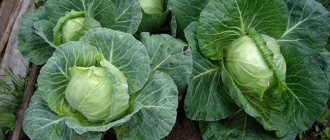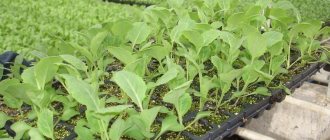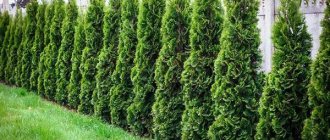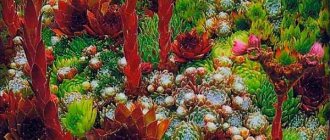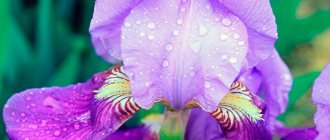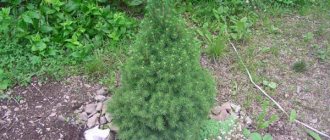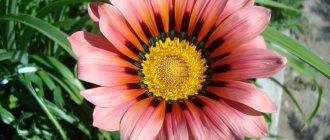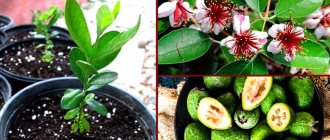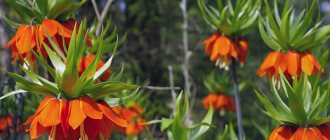Selecting a type and variety
Not every spruce can be cultivated indoors. Many experts advise planting only 3 types of this plant:
- Blue spruce;
- Norway spruce;
- Araucaria variegated.
Photo of a young blue spruce
The latter has nothing to do with spruce - it is a tropical plant similar to spruce. And in terms of care, raucaria is also similar to spruce trees; exotic lovers can grow it at home.
The best option is to purchase a grown seedling from a specialized store or ask friends. It should be remembered that when growing spruce from a twig, a finished seedling can only be obtained in the second year of growth. This propagation method is most suitable for varietal plants, especially blue spruce.
Someone will say: “You can dig it up in the forest and bring it home.” No, a spruce from the forest with a high degree of probability will not be able to take root; its needles fall off less often and more often than in varietal plants.
Choosing a variety
The choice of a New Year tree with subsequent planned replanting should be as careful as the selection of any planting material. It is important that the type of Christmas tree matches the climate zone in which you live. In the middle latitudes of Russia, the following types of spruce trees can be planted:
- common (Picea abies);
- prickly (Picea pungens);
- Canadian (Picea glauca);
- Serbian (Picea omorica);
- kidney (Picea gemmata), etc.
Suitable pine trees include European (Pinus cembra), Siberian (Pinus sibirica) and common (Pinus sylvestris). If you choose fir, then let it be varieties such as Siberian (Abies sibirica) or graceful (Abies gracilis). You can also use juniper of the Juniperus variety for this purpose.
How to grow a spruce from a branch
It is recommended to take a cutting from the top of a young spruce. After the tip of the cutting is cleaned, for 30–40 minutes. dip it in a pale pink solution of potassium permanganate. Afterwards, all the needles are removed from the section of the branch in the lower part.
It is best to plant cuttings for rooting in a container with manure at the bottom, and fill it with a substrate consisting of sand and earth (1:1). To prevent the cutting from getting burned, the layer of soil mixture must be quite thick, but at the same time the plant must receive the necessary amount of heat released by the manure. The lower part of the cutting is buried 50–70 mm into the substrate, while the plant must be provided with reliable protection from direct sunlight. A young seedling can be planted in a permanent pot only when it is well established (1–2 years).
How to replant
As soon as the soil begins to settle, in late February - early March, it is advisable to plant the Christmas tree in open ground. Specific planting conditions are determined by the type of conifer you choose. But in most cases they prefer areas where the groundwater level is low. But such trees do not like drying out. Loams and sandstones are optimal for them. The soil around the trunk should not be too dense.
Prepare a hole with steep walls for planting a tree; its size should be slightly larger than the earthen ball with the root system, about 20 cm on all sides. Drainage in the form of broken bricks is laid at the bottom. The tree is removed from the container, being careful not to destroy the lump near the root system, and placed in a hole. Then they fill it with soil, lightly compacting it around the roots and trunk. After planting, you can use any of the root-forming stimulants. A transplanted Christmas tree needs shading, since a young tree can get burned under the spring sun's rays.
Features of caring for spruce indoors
Growing
In order for a spruce grown in the house to grow and develop within normal limits, it must be provided with good care:
- the air temperature should be from 15 to 25 degrees;
- sufficient amount of light;
- moderate watering (the water in the soil should not stagnate, and the earthen clod should not be allowed to dry out);
- protection from mechanical damage and timely implementation of preventive treatments against diseases.
Substrate selection
Spruce grows well in a soil mixture with a weak or moderately acidic reaction. The best option is to use loam or sandy loam, while oily or heavy soil is not suitable for such a tree. The lump of earth in the container should always be a little damp, and water stagnation in the root system should not be allowed. When the tree is watered, you need to carefully loosen the surface of the soil mixture, not forgetting that its roots are very close to the surface of the soil.
Make sure that the soil mixture in the pot is not overly compacted, and also do not allow it to dry out or crack on the surface.
How to water depending on the time of year
A Christmas tree grown indoors must be systematically watered from the first days of spring until the end of September. As frost approaches, watering should be gradually reduced. It is necessary to moisten the tree in the middle of winter once every 20 days, and the air temperature in the room where it is located should not fall below 6 degrees. If the room is colder than 0 degrees, then watering should be reduced to once every 30 days.
When growing a Christmas tree, it should be taken into account that while it is young in the summer, it must be protected from direct rays of the sun, in late autumn from a sharp drop in temperature, and in winter from freezing of the substrate in the container. To protect from the sun, you can use shady shelters, canopies from frost, and protective windings from freezing. When preparing for winter, it is recommended to mulch the surface of the substrate with organic matter, while the trunk can be covered with spruce branches or wrapped in burlap.
Container maintenance of spruce
It is not necessary to transplant the tree from the pot into the ground. You can keep it permanently in a container. In this case, you will not have to buy a new Christmas tree every year. All the time, the Christmas tree in the container will grow in the garden, buried in the ground or installed in a decorative flowerpot. And by the New Year she will need to move into the house again. Of course, this is a rather risky way of growing. It requires increased care. It is important to choose especially frost-resistant varieties for this. It is also necessary to ensure gentle acclimatization of the tree when transferring it to warmth and back to the garden. This option is possible if you live outside the city or in a city mansion with a plot of land. Here the tree can be first placed on the veranda and later brought into the house, and vice versa.
If you are not afraid of the new responsibilities that will arise with the purchase of a Christmas tree in a pot, and you are ready to pay attention to caring for the tree, then there are no obstacles to purchasing a green Christmas tree in a pot. If caring for such a tree seems too burdensome to you, but a felled tree also causes you pangs of conscience, then install an artificial tree. Modern artificial trees are very beautiful; they do an excellent job of creating a New Year's atmosphere in the house.
How is spruce useful in the house?
Everyone knows that coniferous plants release a lot of useful substances into the environment, which help fight a large number of diseases, soothe, and have a beneficial effect on the cardiovascular and nervous system; spruce needles are no exception. It is no coincidence that most sanatoriums are located, as a rule, in coniferous forests. We have the following materials about the benefits of coniferous trees: Use of pine needles in cosmetics | The benefits of coniferous forests and a separate article about the benefits of spruce.
Growing a spruce indoors is not at all difficult, and it will always delight you with its unusual beauty and pleasant aroma. And during the winter holidays, it can become the main decoration of your home, of course, if you care for it properly.
Another interesting article about growing unusual plants at home: Growing myrtle
Comments (14)
Irina Vitalievna
04/01/2018 at 00:11 |
We tried to grow spruce with our own hands from seeds and even cuttings, but nothing worked out for us. We decided not to grow from scratch anymore, but came to the nursery and bought ready-made plants in pots for 2-3 years.Answer
Expert Fruit Garden
08/19/2018 at 21:39 |
Good afternoon, Irina! Most likely, your seedlings were affected by the “black leg”. This fungus is a malicious pest of young plants growing on black soil. Therefore, I want to offer you a method of getting rid of this scourge.
Take soil for conifers from under adult plants of the same species. After sowing the seeds, sprinkle the soil with calcined river sand, 0.5 cm thick. In this case, the risk of seedlings being damaged by the “black leg” will be minimal!))
Answer
Marina
04/02/2018 at 00:16 |
If I understand correctly, then the type of tree should be special and not the same as what grows on the street. Otherwise, I can’t imagine how to grow such a tree at home, it will take up a lot of space.
Answer
Expert Fruit Garden
09.13.2018 at 12:05 |
Hello, Marina! Nowadays, garden centers offer a huge variety of conifers. Among them there are those that grow well at home. For example, the Goldcrest Wilma cypress, bred on the shores of Foggy Albion. In addition, do not forget about the Japanese culture of creating bonsai (dwarf trees that successfully grow in closed ground conditions). You can read more about this in Leila Dhanda’s book “BONSAI Culture - Growing Dwarf Trees”.
Answer
Julie
07/01/2018 at 12:33 |
But we have a Christmas tree growing, although it’s really quite small. We found her in the park, under another huge tree. I don’t know what it grew from there, maybe from the seeds of a cone. The fact is that the paws of the large Christmas tree did not allow it to grow at all. And after permission to carefully dig it up (and we literally dug it up with a penknife), the Christmas tree was transplanted into our garden. Now she is about 30 cm, beautiful and green. We will definitely decorate it for the New Year.
Answer
Yulia Expert Plodogorod
01/09/2020 at 15:44 |
Hello Julie! Young plants, even conifers, which are considered frost-resistant, must be covered for the winter. Preparations should begin in the autumn. It is worth removing all debris and litter under the plant; pathogenic bacteria and spores, as well as pests, can develop there.
The area under the plant should be mulched with peat or sawdust, and young spruce should be treated with fungicide in dry and windless weather. You can wrap the conifer 3-4 days after the procedure. If precipitation occurs after spraying with the preparations, you will have to repeat the treatment.
Since the tree is small and not yet very strong, it is worth installing a wire structure around it. Otherwise, the plant may break under the weight of the snow. A shelter is placed on the frame. It could be spruce branches. It is often laid in the shape of a hut. If the branches for wrapping are strong, additional structure may not be required.
As an alternative, you can protect the crop from frost with agrofibre, burlap or other material. It is important that it is breathable. We recommend holding off on decorating your conifer for the New Year for now, otherwise the tree may be damaged by frost.
Answer
Olga
07/29/2018 at 08:07 |
I remember our New Year tree was taking root. So they threw them away. It sat in the water for a couple of weeks, water was added regularly. I wonder if if you planted it with these roots, would it take root?
Answer
Expert Fruit Garden
09.13.2018 at 12:38 |
Good afternoon, Olga! If your spruce has taken root, that’s great. But in order to plant it in the ground, you would have to crown all the branches, “as much as I can.” The fact is that in plant growing there is a formula according to which the diameter of the crown (during transplantation) should be less than or equal to the diameter of the root system. This is necessary so that the seedling can receive enough nutrients to feed the crown. As for your spruce, unlike hardwoods, the tiers of spruce branches contain very few dormant buds. So, in your case, you could end up with a spruce tree that is perfect for shaping into a bonsai, in the style of "Resists Adversity". However, I have some good news for you. The fact is that a plant capable of producing roots passes on its characteristics to its vegetative offspring (read about the technique of cutting conifers). If in the first generation of cuttings, out of 100 units, 2-3 take root - that’s already good! Cuttings taken from these seedlings can show an efficiency of 40%. The third wave of cuttings is capable of producing a plant in which 100 cuttings out of 100 possible take root. So - Go for it! The one who walks will master the road!!!
Answer
Olga Tomilina
01/04/2020 at 07:25 |
In general, of course, people are interesting. Our village is located almost in the forest. There are a large number of pine and spruce trees around. But no, people also plant them in their gardens. The question is why they do this, I don’t understand.
Answer
Yulia Expert Plodogorod
01/09/2020 at 18:27 |
Hello, Olga Tomilina! If there is a coniferous forest nearby, this means that such plants will take root in the areas much better than in other conditions. Suitable soil and atmosphere contribute to this. You can plant even capricious ornamental crops.
In addition, other ornamental plants cannot always develop in conditions suitable for pines and spruces. After all, these crops prefer poor, drained and acidic soils.
Coniferous trees are often used as landscape design elements. You can supplement the rockery with conifers and plant it near the house to create shade. Planting annual and perennial small flowers under pine trees brings the garden closer to a natural style. Many plot owners who mainly come there for recreation like this view.
If there is a coniferous plant in the garden, especially a fairly large one, you can decorate it for the New Year. With this approach, the tradition of decorating a live Christmas tree or pine tree is preserved, but the tree itself does not suffer.
Answer
Alina
03/08/2020 at 00:17 |
And if a purchased Christmas tree in a pot woke up in winter and began to grow, is there any point in replanting it later outside? Will she survive? I often hear that spruce bought in a pot rarely takes root.
Answer
Yulia Expert Plodogorod
03/09/2020 at 01:52 |
Hello, Alina! If a Christmas tree at home began to develop in winter, most likely the temperature was inappropriate. This disrupts the natural biorhythms of the culture, which will affect its immunity. Sometimes the described plants gradually wither and die.
This plant can be transplanted into open ground. Under natural conditions and with enough space for rhizome development, the tree can recover. But, the young seedling will require careful care.
Although this is an outdoor crop, a plant that has spent the winter at home needs to be aired for several weeks and accustomed to the new microclimate. It is better to carry out the transplantation process when it is warm enough. For example, in April or even in May.
It is important to carefully protect the transplanted coniferous plant from direct sunlight, for example, by placing a protective screen in front of the tree or using a diffusing mesh. Otherwise, burns will immediately appear on the crown, and the tree will die from dehydration. For the same reason, when the crop takes root, regular watering with slightly warm water is important.
It is better to plant the plant using the transshipment method, preparing the hole in advance and laying a thick layer of drainage there. In the first month you should not feed the ephedra. Watering can be carried out not only at the root, but also by sprinkling.
Answer
Alina
03/11/2020 at 00:35 |
Thanks for the advice!
Answer
Alexei
03/26/2021 at 19:27 |
I'll squeeze tomorrow
Answer
Varieties of Christmas trees for planting in a pot
Of course, you can go to the nearest forest, collect mature cones and plant the seeds in a pot. But you should know that there are other varieties that are more suitable for pot growing, namely:
- dwarf spruce conika;
— prickly spruce, Serbian;
- decorative blue spruce of Dutch, Danish, North American or Russian varieties
- fir growing in Siberia, Korea or the Caucasus Mountains;
- columnar western thuja.
Experts advise that the easiest way to grow spruce and prickly spruce in pots.
There are only three ways to grow: seeds, cuttings and seedlings.
You can find tips on growing a tree from seeds on our website.
It is very difficult to grow spruce from cuttings, although it is possible, due to the fact that it has poor root formation.
Let's take a closer look at the third option - buying seedlings.
In the store, you should carefully inspect the plant; it must be without flaws. Be sure to check the root system by asking a store employee to carefully remove the tree from the pot. The entire lump of earth should be penetrated with small roots, the earth should be held tightly. If the earth crumbles from a lump, and thick roots peek out from it, most likely the tree was not grown in a pot, but was transplanted there with a ready-made tree. This happens, and the tree will soon die. At home, you need to transplant the tree along with a lump of earth into a pot with a larger diameter of 2-3 cm, making sure that the planting level is not buried.
The soil in the pot should always be sufficiently moist. In addition, you need to spray the plant once a day. Do not place it near radiators. There should also be enough light.
After several days of holidays, the tree should be moved to a balcony or closed loggia with a temperature of +6-+10 degrees.
Place of purchase: nursery only
You can get a Christmas tree in a container in stores or garden centers. Someone may even decide to save money and risk digging up a small tree in the nearest forest or park, especially if the winter is warm and there is little snow. But this method of creating a New Year tree is equivalent to unauthorized cutting down, and such an action is punished quite severely. No need to spoil your holiday.
If you decide to decorate your house with a live tree in a pot, then it is better to go to a nursery rather than to the store. It is known that almost all conifers do not tolerate transplantation well. And if you intend to place your Christmas tree in the garden after the New Year holidays, then try to choose a tree that was originally grown in a container and was not transplanted into it before selling.
Transplantation into the ground
After 3 years, the seedlings can already be planted in a permanent place in the ground. Replanting should also be done in the spring, keeping the soil on the roots as much as possible.
The minimum distance between spruce trees is 4 m. If you plan to replant them again in the future, the distance can be reduced to 1 m.
Typically, a spruce reaches a meter in height by the age of five. During this period, the final transplant to a permanent place is carried out, if this has not been done previously.
| Spruce trees older than 5 years do not tolerate transplantation well - this must be kept in mind |
Types of fir trees
For those who decide to grow a Christmas tree at home, it is better to pay attention to such unpretentious and inexpensive species as common spruce or prickly spruce. Serbian spruce is very hardy, the dark green needles of which are illuminated with silver below.
When you click on the picture it will enlarge!
| Norway spruce | Prickly spruce |
| Serbian spruce | Serbian spruce |
There are dwarf spruce species: Canadian spruce Conica (the height of a ten-year plant is about 50 cm) or common spruce Nidiformis (30 cm), which can fit in an apartment, but their appearance is somewhat different from the traditional one.
| Canadian spruce Conica | Norway spruce Nidiformis |
Possible problems when growing spruce at home
The needles turn yellow and fall off . This is usually a consequence of errors in care (temperature conditions, improper watering, sunburn). Affected branches are not restored. You can change the conditions of detention and spray with bio-regulators (preparations that increase plant immunity are sold in specialized stores).
The needles lost their shine and wrinkled. The earth mixture is not sufficiently oxidized. It is necessary to add soil from under coniferous trees to the top layer of soil. You need to be very careful: firstly, do not expose the roots of the plant, and secondly, do not allow the ground level to change, that is, do not plant the tree deeper than it was before.
Irina Surdu specially for the site All about flowers
© 2010, All about flowers. All rights reserved. The use of site materials in any form is prohibited. Copying articles with a link to the source is only with the written permission of the site administration.
The forest beauty is an indispensable guest of the New Year holidays, but it can please the eye at any other time of the year. To do this, you just need to purchase not a cut tree, but in a pot or tub. You can buy this kind of Christmas tree online without any problems.
But for it to take root, you will need to put in a little effort and use the tips given in this article. They will help you grow a real stately beauty from a small Christmas tree.
Tip #1. To grow a Christmas tree in a pot, it is best to buy a common or prickly spruce. These species are the least demanding, so there is a high probability of achieving a positive result. And given that in nature spruce is a tall, powerful tree, dwarf species are most suitable for growing at home. The specialists of the New Yolki online bazaar will definitely enlighten you to such subtleties if you call (495)798-77-67,). The range includes Christmas trees in pots that can be grown at home.
Tip #2. Create favorable conditions for the plant. This applies to aspects such as lighting and temperature conditions. The spruce should be protected from direct sunlight, although there should be enough light. In spring there is a possibility of burns, which is very harmful for seedlings. The optimal temperature in the cold season is considered to be +6…+10, so it is best to keep the container with the plant in a glassed-in loggia. In summer, do not forget to ventilate it. Under no circumstances should the soil freeze or dry out, otherwise the tree will die.
Tip #3. Proper watering and feeding. Three seasons - from spring to autumn - abundant watering is recommended. It is very important to monitor the uniformity of soil moisture. Both drying out and waterlogging will be harmful. The frequency of watering depends on the temperature: at +5...+10 - once every 2-3 weeks, at 0 degrees - once a month. It is also necessary to moisten the crown of the seedling. It is especially important to do this if live Christmas trees are in a heated room during the cold season. For feeding, the usual means used for plant growth are suitable.
Tip #4. The soil for planting must be acidic. In stores you can find one designed specifically for planting coniferous trees. If you decide to mix it yourself, then use equal proportions of the universal mixture and soil from a coniferous forest.
Tip #5. When planning to replant a Christmas tree, be very careful with the root system. Exposed roots and violation of the integrity of the earth clod will lead to the fact that the tree will not take root. The most favorable time for “moving” is the end of spring. Frequency – once every two years.
If you have already decided to buy a Christmas tree on the Internet, then the New Christmas Tree online store is ready to help make this wish come true. Above are the phone numbers you can call and place an order, and you can preview the assortment by visiting our online bazaar website at And may the forest beauty please you 365 days a year.
(
vote(s), average:
out of 5)
Spruce is the most beautiful and capricious tree that you can try to grow at home. After all, it requires special care. In natural conditions, the coniferous beauty is resistant to frost and does not tolerate the warm air of home conditions at all.
To avoid buying a barbarically cut down tree on New Year’s Eve, you can grow it yourself. It is known that under natural conditions a tree can live for 200 years. A spruce grown at home after three years should still be transplanted into open ground. But until this time comes, you can enjoy your personal coniferous masterpiece.
In order for a tree to grow, it is necessary:
- Landing
- Watering and fertilizing
- Temperature
- Proper care
- Lighting
As a rule, many people dream of growing a spruce tree on their own, but before you start this difficult task, you need to be confident in your abilities. Painstaking work and proper care will provide you with two or three years of observing the growth of the forest beauty.
There are three ways to grow a coniferous beauty at home:
- seeds
- cuttings
- seedlings
Breeding spruce from seeds
Under natural conditions, seeds fall from the fruits of the tree, cones, which fall to the ground in the fall. Then they remain under a layer of snow all winter and only towards the end of February, at the beginning of May, they begin to germinate.
At home, you can speed up this process, due to the fact that there is no snow at home, the seeds are sown in a container at a distance of 5 - 6 cm. The sand should be moist, but the water should not stagnate, otherwise the seeds may rot. This container is placed in the refrigerator on the door or in the vegetable drawer. You can keep it for a month, but it’s best until spring.
When the daylight hours become longer and last up to approximately 17 hours, the container with the seeds should be taken out and placed on the windowsill near the radiator. This will bring the crops closer to natural conditions. During this period, the seeds need abundant watering, since in nature the snow begins to melt and the soil is quite moist. Those who germinate seeds for the first time need to be patient, because after 12 - 16 days there will be shoots on the window.
Young shoots must be watered so that the soil is moist. During this period, you can introduce irrigation with fertilizers. Under natural conditions, humus of pine needles and cones is fertilizer.
As soon as the young seedlings get stronger, they need to be transplanted into separate pots. It is best to dig up the soil in a coniferous forest; if there is none nearby, a soil substrate is purchased for growing coniferous plants.
As soon as the young shoots began to grow together, place them in the window and make sure that there is enough lighting. It is necessary to darken only when direct rays of the sun hit the plants. They can cause burns to young shoots.
Direct sunlight deforms the branches and can lead to the death of the plant.
As soon as the cold weather passes and stable warmth sets in, usually in May, small spruce trees can be taken out into the open air: balcony, terrace or loggia. At the first frost, bring the trees into the house, and in winter, make sure that the plant is in a bright room with a temperature of a maximum of 15 degrees.
Breeding spruce cuttings
Before planting cuttings, you need to prepare nutritious soil. It is best to cut the cuttings from a tree that is 6–9 years old. You need to take a one-year-old twig from above. Clear the tip of needles, place it in a weak growth stimulator for 5-10 minutes and then transplant it into the soil at an angle of 30 degrees. Cover the planting immediately with film. Planting of cuttings is carried out only in spring or autumn. Watering the seedlings should be done as the soil dries. Don't forget about fertilizers.
Trees grown from cuttings take root much faster, but they will not stay at home for long, and after only a year you will have to say goodbye to your home spruce, since for its normal existence it must be planted on the site.
Planting coniferous seedlings
Seedlings are purchased in stores or greenhouses. It is best to buy them in spring or autumn. You will not have any worries about growing it; the finished tree will delight you for two to three years.
“After purchasing seedlings, they need to be transplanted into another pot, while making sure that the roots of the plant are not exposed and that the lump of earth is intact. It is necessary to replant to the same depth as before.”
Watering and fertilizing
Spruce is a capricious tree, so it must be properly cared for, especially watered. The earthen ball should be constantly moist. Overwatering or dryness can lead to the death of the plant. The plant should be watered with the addition of mineral fertilizer from May to September. Fertilize twice a month. When the dormant period begins from November to March, fertilizers are completely cancelled.
During the winter dormant period, special care must be taken for the spruce; if it is at home, it is necessary to spray the needles with a fine sprayer if there are heating devices in the room.
Watering is reduced to 2 times a month if the regime is maintained from 5 to 15 degrees. If the spruce is in a cool room, in which the temperature is about 0 degrees, watering once a month will be enough.
Temperature for normal growth of spruce
“Spruce loves cool weather and does not tolerate warm air in winter”
In summer, the temperature can be different, the young tree will endure everything, but if there is stagnation of air, it will begin to hurt. In summer, the room where the spruce grows must be ventilated.
In winter, coniferous plants must be given a period of rest, otherwise they will become depleted and quickly die. The optimal temperature in winter is 5-15 degrees. Although a tree can easily tolerate a drop in the thermometer to zero or below, the main thing is to ensure that the earthen lump does not freeze.
Proper care
By observing all the necessary requirements for maintaining spruce at home, you can enjoy the smell of pine needles. But those who like the forest beauty can grow it every year, and when the tree reaches maturity, plant it in open ground. This is necessary because the spruce root has a wedge shape during the first 15 years, and only then does it dry out, leaving behind lateral branches. The deeper the root goes into the ground, the longer the spruce will grow. Unfortunately, at home we are not able to provide sufficient depth for the root.
Don’t be sad, because new shoots are sprouting on the window, and three-year-old beauties will decorate your garden plot and become a wonderful memory for your heirs.
Lighting
Spruce is a light-loving plant, but young seedlings do not tolerate direct sunlight on the needles. But mature trees love the sun and are drawn to it. In winter, young trees must also be provided with lighting, since if there is not enough light, the tree will die. During the dormant period, spruce undergoes photosynthesis processes, but at a slower pace.
If you lovingly care for the spruce, then the spruce will respond to you with its love and beauty.
On the eve of the New Year, the question of the Christmas tree as the main symbol of the holiday arises more and more acutely. Opponents of a plastic tree in an apartment understand that a spruce cut down in the forest is not a solution, because it costs a lot, but it will begin to crumble quite soon. The most logical solution seems to be to grow and decorate a plant in a pot for the holiday - minimum costs, no cleaning, and not a single Christmas tree will suffer due to traditions.
Sowing
Before sowing the seeds, be sure to moisten the soil well with a spray bottle.
- Make 1.5 cm holes in the soil and sow the seeds, spacing one another at least 4 cm.
- Sprinkle the seeds with a layer of peat and nutrient soil in equal parts.
- Cover the containers with cling film.
Before the seeds germinate, place the container on a south-facing windowsill and keep the water moist by periodically moistening it with a spray bottle.
Seedlings usually appear on the soil surface after a couple of weeks.
More reliable from seeds
Oddly enough, the most reliable way to grow spruce is from seeds. The tree will be in your home from its very birth and will be able to quickly adapt to environmental conditions. In addition, buying a seedling in a nursery will cost a considerable amount, and the conditions in the nursery are different.
Spruce seeds prepared for planting
However, it is best to purchase spruce seeds at a nursery - the people who work there are knowledgeable, and the products there are, as a rule, of high quality. If you want to complicate the task, go into the forest yourself in late autumn and collect fir cones. The seeds extracted from them will become material for future work.
You can collect the cones in winter, bring them home and dry them until they open on their own - then remove the seeds.
There is one important point associated with growing spruce at home. We are talking about a constantly warm temperature that will not give the spruce time to rest, which is usually easily achieved outdoors. At home, coolness can be ensured with the help of a balcony, where during cold weather you will need to take the coniferous beauty out, gradually accustoming it to the cold. If you do not have a balcony, it is better to abandon the idea of growing a spruce.
However, if you are growing a spruce at home for further planting in open ground, the first two warm seasons will not ruin things.
And so she came to us dressed up for the holiday...
Or rather, you yourself brought her into your house under green hands! A Christmas tree in a pot is a rather capricious guest, as it is difficult to put up with room conditions where the air is excessively dry and hot, so our good advice will come in handy.
Christmas tree in a pot - the guest is quite capricious, as it is difficult to put up with room conditions
- Remember that your Christmas tree is a living creature. Don't overload it with decorations! Use the lightweight version, taking care of fragile branches.
- Try to bring the conditions of your apartment or house as close as possible to natural ones: make sure you have an air humidifier in advance. If you don’t have an electric one, then some kind of container with water will do: the moisture will evaporate naturally. Do not install the Christmas tree next to a radiator, stove or fireplace.
- Harden the tree before bringing it into the house: keep the tree in a cold corridor or on the loggia for several days so that it acclimatizes and easily survives the temperature difference. Take care of the roots: to prevent the earthen ball from freezing, wrap it in rags, hay or straw.
- As with any indoor plant, the Christmas tree must be watered and sprayed. If you do this with ordinary soft water (rain or melt), then such care is quite traditional. But attention! If you are a supporter of the best possible, then your advanced florist's pantry urgently needs replenishment - the complex organic-mineral fertilizer "Reasil" for coniferous plants.
Tricks and Tips
To avoid disappointment from dead seedlings, you should consider some points when growing them, for example:
- purchase varietal seeds only in trusted stores;
- if possible, sow in special large cassettes (tablets) for seedlings;
- at first, water only by spraying;
- remember that the tree is afraid of direct rays of the sun until it is 3-4 years old;
- try not to keep pots with seedlings at temperatures above 18-20 degrees;
- do not delay the transplant: at the age of 5 years it is already very risky;
- if the soil on the site is very poor, when planting, you can add 100-150 g of complete mineral fertilizer to the hole; They don’t feed the spruce anymore;
- in regions where snow falls late, it is worth covering the Christmas tree with non-woven material for the first winter.
Growing spruce from seeds is both easy and difficult: while almost any experienced gardener can get seedlings, achieving 100% survival of seedlings is more difficult. However, after a few years, all problems go away, and an adult tree grows with virtually no care; it can outlive the owner, his children, and even grandchildren.
So how to care for your homemade spruce? What to do to prevent the Christmas tree from dying?
As you can see, Christmas trees are very durable even in apartments, provided that you transplant them into nutritious soil and place them in a cooler place . We did not take any special measures to care for our homemade spruce. At the same time, the Christmas tree feels great, and after almost three months it has not died. I believe that the Christmas tree blossomed for the reason that two months of growth on the balcony became a stress factor for it, and as conditions improved, it began to actively grow. However, the larger the home Christmas tree becomes, the more difficult it will be to attach it somewhere, so when buying small indoor thorns, consider whether you will have a place for it after it grows.
Important! For those who are worried about the future fate of the Christmas tree - at the first opportunity, the Christmas tree will move to live with her mother-in-law in a private house on her property.
Conifer diseases
Coniferous ornamental plants are susceptible to infections, but timely detection of their signs and immediate treatment will help avoid dangerous consequences.
- Rust. It appears as orange coatings on the branches. The needles turn yellow and fall off. Weekly treatment of the crown with drugs such as Glyocladin and Vectra will help.
- Schutte's disease is caused by a fungus. Signs: the needles become covered with a white coating, darken and crumble. If the situation is not neglected, the plant can be cured by first spraying it with a solution of copper sulfate, then treating it with Alirin-B and Trichodermin.
Transshipment
Usually, in early spring, seedlings are transplanted, or rather transferred to larger containers in the same soil. When transshipping, try not to disturb the earthen coma.
| IMPORTANT The more soil you retain on the roots, the higher the likelihood that the seedlings will take root and continue to grow and develop. |
- Replanting should be done as quickly as possible so that there is no even minimal risk of the roots drying out.
- To speed up the process, make holes in a new container in advance and pour water over them.
- Next, transfer the seedlings, add soil if necessary, compact it around the planted plants and water again.
You should know that the most dangerous period of growth for seedlings is from the moment shoots emerge above the soil surface until they reach 3 years of age. During this period, up to 60% of plants usually die.
What to do with the plant after the holidays
But now the fireworks have died down, the bells have rung and the traditional time for receiving guests has ended... We are wondering about the future of the coniferous tree.
Most potted “Christmas trees” are open ground plants; for successful growth and development they need a cool winter and moist air. How cool is it and where to provide it - a window sill, a cold or insulated balcony (loggia), a winter garden, a summer house?
Now we urgently need knowledge about the species of the “Christmas tree”, because from it we can judge the winter hardiness of the plant. Heat-loving plants are often found on sale: Italian pine 'Silvercrest', as well as "Turkish firs", one of the parents of which is Greek fir. Of course, such beauties from the far south will not survive the harsh winter of central Russia. The average temperature of their winter maintenance ranges from +4°C to +10°C, which, of course, cannot be ensured in residential premises.
A frost-free balcony with the possibility of heating or (at worst) a staircase can be their salvation. Such a plant must be given the brightest place and provide minimal watering, preventing the earthen clod from drying out.
If you decide to keep your “Christmas tree” in your apartment or plant it in the garden, first find out what type and variety it is, understand whether this plant is winter-hardy
Please note that the vast majority of potted “Christmas trees” come from Europe, which means that even winter-hardy species in the middle zone (which are still the majority among potted spruce trees) will need shelter in the garden for the first 2-3 winters, because where they come from, winters much softer than Russian ones.
The wintering of cypress trees is quite problematic: K. Lawson, K. obtuse and K. thuja (its cultivar 'Top Point' is most often found as a New Year's tree), Nordmann fir (sellers call it Danish spruce) and P. monochromatic, thuja folded 'Gelderland', black pine 'Oregon Green', Chinese juniper 'Stricta', as well as Geldreich pines 'Malink' and 'Compact Gem', popular in Europe.
My advice is that it is better to grow them in the southern regions of our country, but if you want to try to save the tree and plant it in central Russia, then they should be carefully buried in the snow and eliminate the possibility of burning in early spring.
In the first 2-3 years, the young plant will need shelter for the winter, even if it is suitable for your region in terms of winter hardiness
We take it to the dacha
You can take to the dacha Fraser fir, Arizona fir (sometimes it is considered as a variety of subalpine fir), Scots pine, western thuja, rock juniper ('Moonglow' and other cultivars), Serbian spruce, e. Canadian, e. Scots, e. prickly. It is enough to simply bury them “headlong” in a snowdrift - if there are no serious thaws and subsequent severe frosts, the trees will overwinter well, and in the spring they can be planted.
Please note that spring dangers threaten Canadian spruce 'Conica', Chinese juniper 'Stricta' (early spring burns), subalpine fir and Siberian fir (damage to young shoots by late spring frosts). To prevent burns, it is advisable to install a border shield or pre-wrap the plant with a border mesh or burlap.
In spring, coniferous plants must be protected from burns
Digging in the shade is undesirable - there the snow lasts longer, which means the growing season begins later. Temperature changes are extremely undesirable for any conifer, so before moving to the country, especially if there is severe frost, it is better to keep the plant on a frost-free balcony for 3-5 days.
Criterias of choice
Healthy look . When choosing a “Christmas tree” in a store, give preference to healthy and strong (in appearance) specimens, with a moist substrate, without broken branches. This does not mean that purchasing a plant with several broken branches and a dried out lump is excluded, but the risk that it will not survive increases significantly.
Choose healthy plants without broken branches
Nice appearance. When you choose a “Christmas tree” for temporary home decoration, it is not so important what genus and species the plant belongs to, the main thing is that you are satisfied with its appearance.
If you plan to subsequently transplant the tree into the garden, then you should think about its species characteristics in advance. I’ll tell you exactly what needs to be taken into account a little later. In the meantime, let’s find out how to extend the life of a coniferous plant in an apartment.
Replanting large fir trees. How to remove a tree from the ground?
Experts and gardeners say that spruces are most hardy if they are taken from their natural environment, that is, from a nearby forest. They have significant advantages over purchased ready-made seedlings - they are fully adapted to local conditions, which allows them to have higher resistance to the adverse effects typical of a given area. The rapid growth and restoration of vitality of forest beauties is very important for them, which undergo regular pruning.
Therefore, gardeners and owners of country houses and plots prefer to transplant forest spruce onto their land.
When going into the forest to look for a coniferous tree, you need to know that the fluffiest of them grow on the outskirts of the forest.
And so, the spruce you like is selected and carefully examined. It should not have any damage or visible health defects. A large, mature spruce is not suitable for replanting. A short, two-year-old tree, not taller than one meter, is more suitable for this purpose. Then the tree will better tolerate planting in a new place, and the likelihood of damage to the root system of the seedling will noticeably decrease. After all, the older the tree, the longer its roots and the easier they are to damage.
The most difficult task is the need to dig up the spruce according to all the rules. The tree should be dug around the trunk along the width of the largest branches - the depth of the hole should be a little more than half a meter. Carefully remove the planting material from the dug hole, while carefully holding the root soil. Then wrap the lump with a piece of cotton fabric prepared in advance. This will help in transporting the seedling to the transplant site.
It is necessary to take into account the significant difference between the forest soil where the spruce grew and the one in which it will grow further, even if this distance is small. The transplant will be more successful if you grab a certain amount of soil from exactly the hole where the seedling was dug.
If you make a mark on the south side of the trunk of a dug up tree, and then plant it in the same direction as before, the tree will grow healthy and its survival rate will be much higher.


